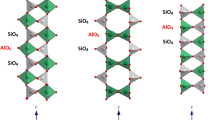Abstract
The thermal expansion and crystal structure of FeSi has been determined by neutron powder diffraction between 4 and 1173 K. No evidence was seen of any structural or magnetic transitions at low temperatures. The average volumetric thermal expansion coefficient above room temperature was found to be 4.85(5) × 10−5 K−1. The cell volume was fitted over the complete temperature range using Grüneisen approximations to the zero pressure equation of state, with the internal energy calculated via a Debye model; a Grüneisen second-order approximation gave the following parameters: θD=445(11) K, V 0=89.596(8) Å3, K 0′=4.4(4) and γ′=2.33(3), where θD is the Debye temperature, V 0 is V at T=0 K, K 0′ is the first derivative with respect to pressure of the incompressibility and γ′ is a Grüneisen parameter. The thermodynamic Grüneisen parameter, γth, has been calculated from experimental data in the range 4–400 K. The crystal structure was found to be almost invariant with temperature. The thermal vibrations of the Fe atoms are almost isotropic at all temperatures; those of the Si atoms become more anisotropic as the temperature increases.
Similar content being viewed by others
Author information
Authors and Affiliations
Additional information
Received: 22 January 2001 / Accepted: 2 July 2001
Rights and permissions
About this article
Cite this article
Vočadlo, L., Knight, K., Price, G. et al. Thermal expansion and crystal structure of FeSi between 4 and 1173 K determined by time-of-flight neutron powder diffraction. Phys Chem Min 29, 132–139 (2002). https://doi.org/10.1007/s002690100202
Issue Date:
DOI: https://doi.org/10.1007/s002690100202




